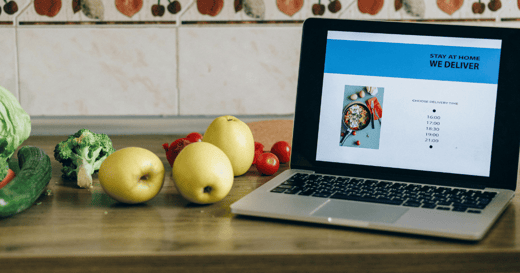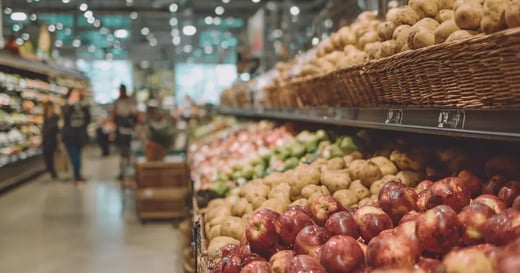Online grocery shopping and local pickup have become regular parts of life, and having a strong online presence is essential to stay competitive with other stores and bigger chains. But that’s easier said than done.
As many grocery store owners know, simply having a website often isn’t enough to drive sales and bring in new customers.
That’s where SEO (search engine optimization) comes in. Following SEO best practices is how businesses increase their online presence and show up higher in local search results — which is a huge deal. Almost half of all Google searches are for local information.
In this article we’ll go over:
Learn grocery store SEO best practices to reach more customers, improve the online grocery shopping experience, and stay competitive.
What Is SEO and Why Does Your Grocery Store Need It?
SEO stands for “search engine optimization,” and refers to the processes used to optimize a website’s content and architecture to be more visible on search engines like Google and Bing.
What makes one website rank higher than another? The answer is a little murky, but more than anything, an SEO-optimized website is full of relevant content that customers find helpful.

Why is SEO important? The higher your website ranks in a search engine, the more likely customers are to find it when looking for a grocery store nearby. Not only that, but customers will be more likely to explore your website further.
Important Note: SEO isn’t just important for businesses that primarily do business online. The vast majority of customers (almost 90%) find local businesses by searching online.
Keywords and Intent: The Backbone of SEO
SEO optimization starts with understanding your customers' needs and what they might be searching for online.
Let’s consider an example.
If there’s a local Japanese market, they probably offer certain products that aren’t in many grocery stores, like fresh udon noodles. Many of their potential customers might be searching for things like “Where to buy udon noodles in (my city)” or “Where to buy fresh udon noodles.” Or, their search might be more general, such as, “Where to buy Japanese ingredients.”

These search terms are called keywords, and search engines use them to find relevant content, along with the intent behind the search.
Intent refers to why a customer is searching for a given keyword and whether a given website is a relevant result.
So, a person searching for “What are udon noodles?” will probably be sent to a Wikipedia page or blog post, whereas a person searching for “Where to buy udon noodles” is more likely to be sent to a grocery store’s website.
In this example, if udon noodles are a popular product, a Japanese grocery store might do things like:
- Include udon noodles on their home page as one of the products they carry
- Write a blog with recipes for udon noodle soups
- Write a detailed product description for udon noodles on their online store
Thinking about the intent behind people’s searches will help you create content that is helpful for customers.
7 Grocery Store SEO Best Practices To Boost Your Online Presence
SEO best practices are evolving constantly as the way search engines index and rank information is changing due to AI and other innovations.
However, these seven tips and tools are still highly effective for helping your grocery store show up online.
1. Focus on Your Overall Site
It’s easy to get caught up in the small details of SEO, obsessing over individual keywords or specific search terms. However, to truly see an improvement in your site’s traffic, start with the basics.
Examine the site’s content. Is it easy to find specific information, such as your contact information, product list, and online shopping options, from your homepage? If not, it might be time to review your website's structure.
Include your grocery store’s hours, location, and contact information in the footer of every page. Have an easy-to-use navigation bar that leads users to their destination.
Many grocery point of sale (POS) systems include e-commerce integrations to help streamline the process of building an SEO-optimized site.
For inspiration, search for other grocery stores and supermarkets and look at their websites. If they show up frequently in local searches, it probably means they are doing something right!
Last, consider a customer’s intent again. When customers visit your website, what information is most useful? Make sure that information is front and center.
2. Be Patient
While the online world moves fast, SEO, unfortunately, does not.
You can’t improve your SEO overnight. If you make big changes to your website or launch it for the first time, it’ll take time for platforms like Google to analyze the content and reorder their search rankings.
If you start an e-commerce site or a blog, it may take several months for them to appear in search results, even if they’re perfectly optimized. Be patient and keep going.
The more regularly you add quality content to your site, the more it will pay off in the long term.
3. Be Specific
If you use a free tool like Moz or just plug some search terms into Google, you’ll notice that general search terms like “grocery store” or “fresh produce” are searched often, but have a lot more competition. On the other hand, more specific terms like “grocery store in (city)” or “local produce store” tend to show local results.
To be frank, your small business isn’t going to be competing with chains that can afford to pay for higher rankings on those search terms.
Instead, focus on creating content that’s more relevant to your customers and area. Use location-specific keywords like the name of your town, county, and state.
You can also work these into other pages and posts on your website. For example, you might write a description on a product page that includes words like “We’re one of the only grocers in (your city) that carries (specific product).”
That way, when people search (specific product) plus (your city), it’s more likely to show up in search results.
Important Note: Being specific is not the same as trying to game the system. Search engines can tell when you’re arbitrarily using keywords for the sake of it and will penalize your site.
Your primary focus should be on providing informative and helpful information to customers. So, instead of trying to blend in with the crowd, focus on using terms that are unique to your business and help you stand out.
If you’re not sure which pages to start on, use the reports and analytics on your POS system to see your bestsellers and product types that customers are most interested in.
4. Check Your Links
Links are great for SEO, but they have to be properly optimized. Links can be internal (links that lead to another page on your website) or external (links to another website).
For best results, use links on words that clearly describe where a click will take a customer. For example, link the word “fresh produce” on your home page to a list of your produce (not to your blog or something not directly related to “fresh produce”). Simple, right?
Using clear and accurate link descriptions is good for SEO and makes your website easier to navigate. Ensure all your links are active and take you to the intended page. If you find a dead link, remove it or update it with the correct one.
For example, if we mention a topic like food safety best practices and it takes you to an article on pricing baked goods instead, we wouldn’t blame you for feeling frustrated.
5. Use Your Images
A picture says a thousand words, which is true for life and SEO optimization.
Images are great for SEO, and search engines love mixed media on a site, such as images, videos, and graphics. Use high-quality photos of your store and your products to make your website more visually appealing and to boost search rankings.
To make sure images don’t slow down the loading of your website, make sure to compress them using tools like TinyPNG or TinyJPG.
You can also include relevant keywords in image names and descriptions. Keywords are vital for SEO, and the more you have, the better.
6. Make A Google Business Page
Creating a free Google Business Profile is one of the best ways to boost your local SEO. It allows your website to show up when people search Google Maps and “near me” searches.
In addition to Google, you can also consider creating business profiles on:
All of your online profiles should include accurate information, including:
- Address
- Contact information
- Store hours (including holiday hours)
- Website address
- Pictures
Over time, you may accumulate customer reviews on your various profiles. This is great! Reviews are a fantastic way to build trust in your brand, so encourage happy customers to leave a review.
Respond to all reviews (including the bad ones) to show off the human face behind your business and address any complaints.
7. Leverage Social Media
Social media is a monster, with tens of millions of active daily users. It’s also a fantastic way to market small grocery stores and highlight your unique personality.
Regularly post on social media using a business profile, showcasing new product arrivals, current sales, seasonal promotions, employees, and more. Consistently posting on social media will help you appear more on people’s feeds.
Link your website and products on social media to create backlinks, which are also great for local SEO.
Related Read: 5 Reasons Why Grocery Stores Should Embrace Social Media to Enhance Their Brand
Boost Local Business With SEO-Optimized E-Commerce
Whether you’re opening a store in a small town or are an established local favorite, having a strong online presence will help you find new customers and stay competitive.
A great SEO strategy will help. Remember these key takeaways:
- Focus on your overall site’s content first
- Be patient. Don’t expect your SEO to work right away
- Use specific words that are unique to your business and location
- Make sure that all of your links work and take you to the right place
- Use web-friendly images to showcase your store
- Set up a Google Business Profile to stand out in local searches
Leverage social media to give your brand a human face. If you want to build an online store but are unsure where to start, we can help.
IT Retail has over 25 years of experience working with small grocery stores and food markets. We offer easy setup and comprehensive e-commerce tools to modernize the customer experience and bring your store online.
Schedule a custom demo today with our grocery experts to learn more.







 by Sarah Hartsell
by Sarah Hartsell



 by Luke Henry
by Luke Henry